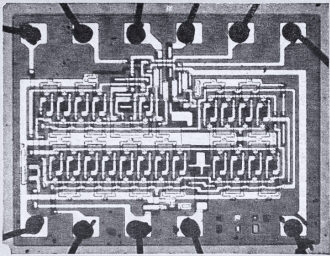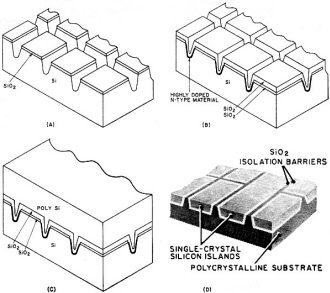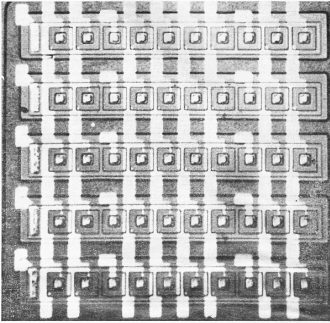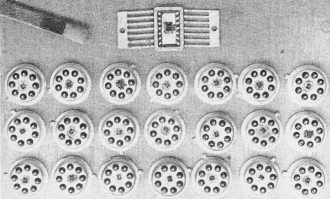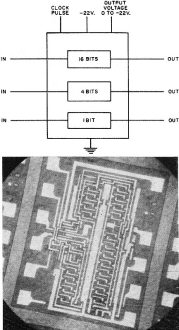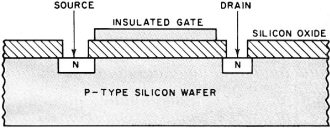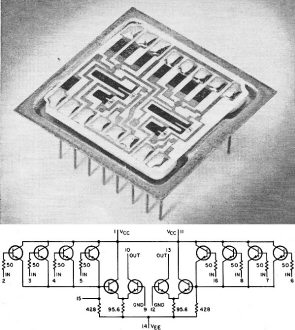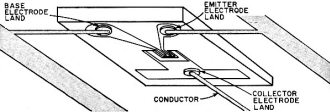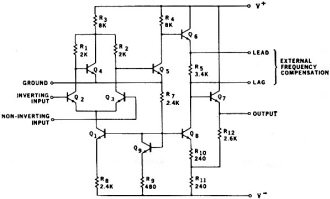Integrated Circuit Techniques
|
|
My first exposure to bare die integrated circuits was in the early 1980's, while working at the Westinghouse Oceanic Division in Annapolis, Maryland. It was my first job as an electronics technician after separating from the U.S. Air Force. After working there on the evening shift for a couple years building sonar systems for the U.S. Navy, I had an opportunity to move to the day shift if I could pass muster for a high level security clearance. A small group of engineers, with just one technician, was formed to serve the needs of a "special" customer. A couple other guys with more seniority them me interviewed for the position, but they failed the background check, which included two polygraph tests ...but I digress. Part of my job entailed building microcircuit assemblies using bare IC die and surface mount passive devices epoxied to very tiny printed circuit substrates, and then using a thermosonic wirebond machine to do the interconnections. 1 mil gold wire was used. A week-long class at the company's plant in Baltimore provided the basics, but the work we did was very unique and required developing new techniques that probably would not pass inspection by the crotchety Navy inspectors. The image shown here of the 21-bit shift register is reminiscent of type die I worked with. Most of the IC's I used were fairly simple logic gates (OR, AND, NOR, NAND, Inverter, etc.) and some flip-flops (J-K, D, RS, etc.), mux/demux's, with an occasional low-function microprocessor thrown in for good measure. We even had our own plastic injection molding machine. I still think staring through a microscope for hours on end is what made my formerly 20/15 eyesight so bad. I could tell you what we did - and you'd love it - but then I'd have to kill you ;-) I honestly have never told anyone, not even Melanie, what we did there. Integrated Circuit Techniques With an emphasis on recent developments in the technology, the monolithic, isolated monolithic, the thin- and thick-film, MOS, and the hybrid techniques are examined. Problems in going from discrete to integrated, examples, and testing are included. By Carl David Todd, Electronics Consultant The already wide and yet expanding field of integrated circuits includes several basic approaches for the fabrication of very small electronic circuits and a vast multitude of combination techniques. Each has its own particular characteristics, advantages, and limitations. Just as the various construction methods in building houses are selected according to the end requirements and desires, so must the particular fabrication process for integrated circuits be chosen according to the specific needs and required characteristics. Since no one integrated circuit technique yet developed can fully satisfy all purposes and required specifications, it is well that we have several from which to choose. In this article we will look at several possible methods for fabricating integrated circuits and discuss their special characteristics with emphasis on their features and limitations. Included will be the monolithic, isolated monolithic, thin-film and thick-film, and MOS techniques with several possible combinations. This article is directed to the engineer and technician who will be dealing with the finished integrated circuit product either in equipment fabrication, checkout, or repair and will attempt to answer the question "What can I expect of integrated circuits?" Even though your present job has no direct connection with integrated circuits right now, you will want to become familiar with them. It is very likely that you will be seeing a lot of them in the near future. The integrated-circuit techniques already developed have allowed a fantastic degree of microminiaturization. Going back just a few years to the time before the "semiconductor revolution," the accomplishment seems even greater. Who would have thought that we could contain the circuit function of a dozen or more tubes with associated resistors and capacitors within the size of this letter "O"? Development of the integrated-circuit techniques has resulted not only in the tremendous reduction of physical size, but has also produced great improvements in the operating reliability of the over-all circuit through the reduction of connecting wires and large, vibrating components. Let's look at some of the common techniques for making integrated circuits and see just what each method can offer and consider where each might run into trouble. Monolithic Circuits Fig. 1 - Isolated monolithic process. (A) Silicon "waffle" wafer showing moats. (B) Oxide grown on moats of wafer. (C) Polycrystalline silicon grown on wafer. (D) Final device. Fig. 2 - Diode matrix made with isolated monolithic process. Fig. 3 - A 21-bit register (top) whose heart is a microscopic wafer of silicon containing 110 transistors and 48 resistors, replaces 21 separate microcircuits (shown here) in computers. Monolithic means "single stone" and a monolithic circuit is one which is fabricated within a single crystal of semiconductor material, usually silicon. The transistors, diodes, resistors, and capacitors are all built right in the semiconductor material. The bulk properties of the material along with the various characteristics of p-n junctions me used. The same basic processes for the fabrication of silicon transistors may be used to make monolithic integrated circuits. The most common ones are the diffusion process, the epitaxial process, or a combination of the two. The transistors, diodes, and passive elements are made at the same time within the body of the silicon by diffusing appropriate impurities through windows cut into an oxide coating by photo-chemical etching. The monolithic process has the greatest single capability of any of the processes. It is possible to fabricate both active and passive components within a very small volume and with all interconnections made by an aluminum evaporation that is etched to provide the desired paths. The technique is basically that which has been successfully used in the preparation of many transistors and hence is quite well developed. One of the main limitations on the monolithic technique is the presence of distributed diodes connecting the fabricated components to the silicon substrate material proper. While it is possible to greatly reduce their effect by making sure that they are always reverse-biased, we still have to contend with leakage currents which may flow and with unwanted coupling capacitances which are present in any diode. Another limitation on the monolithic process is the difficulty in obtaining proper passive components. The range of the resistances which are practical is only about 20 to 20,000 ohms which places a severe restriction on the circuit designer. In addition, the resistors even within the range of practicality have a rather large temperature coefficient (approximately 0.7%/°C). The capacitors are actually reversed-biased diodes and care must be taken to make sure that they stay reverse-biased. Their value, which must be restricted to rather small sizes, will be a function of the applied reverse voltage as is the case with any semiconductor diode. Still another limitation in producing monolithic circuits is the expense in making the precision masks, several being required for each circuit. This restricts the use of monolithic techniques to those applications where large quantities of the same circuit are required. Even minor changes usually require scrapping the finished integrated circuit and an masks. New masks must be made and the entire process repeated. Isolated Monolithic Circuits A variation of the monolithic process which overcomes many problems present with standard monolithic techniques warrants separate consideration. In this approach, portions of the original semiconductor block are isolated from each other either by surrounding sides and bottoms with SiO2 (glass), a very good insulator. Let's look at the basic process as currently being used by Radiation, Inc. The process starts with a lapped and polished silicon wafer about 0.010 inch thick upon whose surface a thin laver of SiO2 is formed by heating in an oxidizing atmosphere. Moats or grooves are then etched around the areas which are to be isolated by a normal photo-etching process to produce the results shown in Fig. 1A. Very highly doped n- or p-type silicon is epitaxially deposited or grown within the groove and then covered by SiO2, formed by heating again. The resulting structure is shown in Fig. 1B. Polycrystalline material (not having a carefully arranged lattice structure as the monocrystalline material required for transistors and diodes) is then deposited over the entire surface. The grooves are filled and the entire surface is covered with a thick coating, as shown in Fig. 1C. The wafer is turned over and the original silicon wafer material is ground off until the polycrystalline material is reached. The surface is then polished and etched to leave small islands of the original silicon wafer from the polycrvstalline material. These islands act merely as a structural agent, via a thin laver of SiO2, as shown in the photograph of Fig. 1D. This photo does not show the heavily doped n-region which is not always required. Each of the isolated islands of silicon may then be treated as a separate chip and processed in the same way as in the normal monolithic process. Very careful control of the thickness of the wafer and the deposited coating is required. Let's look at some of the features of this process. Because of the glass isolation, we no longer have to make sure that we back- or reverse-bias the isolation diodes and we have less than one-tenth the stray capacitances present. Also, the leakage current between elements is greatly reduced, especially if operated at high temperatures. Further, breakdown voltages of 1000 volts between adjacent elements is practical. Another advantage of this technique is the possibility of making both p-n-p and n-p-n transistors on the same substrate and the capability of selective gold doping to achieve different characteristics for adjacent devices on the same substrate. A diode matrix, manufactured by Radiation, Inc. by the isolated monolithic technique, is shown in the photograph of Fig. 2. The glass isolation region may be seen surrounding each row of diodes in the matrix as well as the heavily doped n-regions. The n-regions conveniently tie all of the cathodes of the diodes in a given row together. This photograph also shows an interconnection means in which all diodes are connected to the vertical interconnect buses and then disconnected by blowing out a portion of the metallization. This is done by electrical discharge to remove those connectors not needed in the matrix. Thin-Film Circuits Fig. 4 - A 21-bit shift register. The functional block diagram and a photomicrograph of the actual structure used. Another technique which may be used to fabricate integrated circuits is the evaporation and deposition (usually performed in a vacuum) of metals and dielectrics upon a smooth surface, such as glass or vitrified ceramics. The usual method is to raise the temperature of the material to be deposited above its boiling point in a vacuum. The vapor is then allowed to condense upon the substrate through appropriate masks. The resulting depositions are very thin and are measured in microns (millionths of a meter). Thin-film circuits have the advantage in that higher values of resistance are possible and the temperature coefficient may be held to nearly zero if desired. Because the resistance material is on the surface of the substrate, it is possible to trim a given resistor physically to a precise value. This is achieved by making it a little low in value to begin with and then carefully removing a small portion of the material until the desired value is reached. It is also possible to control the value of the resistance during deposition by monitoring it with a precision bridge. The process is then stopped at an appropriate point and the resistance value "frozen" at that level. Capacitors made by the thin-film process are not voltage sensitive as is the case with p-n junction capacitance. By careful alternation of metal and dielectric deposition during the fabrication process, a multiple plate capacitor having substantial capacitance is possible. Since the dielectric films must be very thin, breakdown voltage can be a problem if even a very small defect occurs during the deposition of the insulating material (usually silicon dioxide). Since the deposition is generally made using a substrate of insulating material, isolation between various parts of the circuit is much better than for the monolithic technique. One of the greatest limitations to the use of the thin-film process in its purest form is the lack of quality active devices. Although development transistors and diodes have been made by this method, they have not been found suitable for general use. The thin-film circuit process has the same problem as the monolithic circuit techniques regarding the requirement for precision masking. If a wide range of resistance values is to be included within a given circuit, the number of masks required is large and the actual number of process steps will almost always be greater than for monolithic techniques. This is especially true if the circuit is complex. Thick-Film Circuits Fig. 5 - Cross-sectional view of an "n"-channel MOS device. Fig. 6 - Photo and schematic of hybrid 4-input gate. It is possible to fabricate circuits utilizing a thick-film technique in which the interconnections and components are applied to a substrate by a silk-screen process. This basic approach has been in use for many years with RC networks found in radios, television sets, and hearing aids. The more recent development of the Cermet materials (basically a combination of metal and glass) has improved the basic capabilities of this technique considerably. Interconnections used in the thick-film process are usually a silver-bearing material and are fired at a rather high temperature. Temperature coefficients for thick-film resistors are not as low as those obtainable with thin-films. Typically, they are much better than those possible with monolithics. Thick-film capacitors may be quite large in value since the dielectric to be screened can have a large dielectric constant (300 to 500). Breakdown voltages can be made as high as needed by increasing the thickness of the dielectric. This, however, will decrease the capacitance. No thick-film active devices are currently in use. We must therefore combine thick-films with active devices made by an-other process, as discussed later in this article. MOS Technique The metal-oxide-semiconductor (MOS - a field-effect device) process had been applied to monolithic integrated circuits with notable success. Because the active components on the chip are essentially insulated from each other, isolation gimmicks are not required. The technique lends itself to low-cost, high-density digital integrated circuits. These devices have a lower frequency response than other devices and consequently clock rates for digital functions are limited to a few megacycles. An example of the use of this new process is a 21-bit shift register developed by General Instrument Corp. (Fig. 3). The silicon wafer measures 0.07 inch long and 0.06 inch wide and contains 110 transistors and 48 resistors. Clock rate is 500 kc. and the unit replaces 21 separate microcircuits. Fig. 4 is a block diagram and a photomicrograph of the circuit. (Also refer to the cover illustration.) The register is actually three shift registers in one package sharing a common supply and clock pulses. The three can be used either independently or connected in series to give a total of 21 bits of delay to an arbitrary data stream. By letting the output voltage be just a few volts, it is possible to have the register drive other types of low-voltage n-p-n logic. Fig 5 provides a cross-sectional view of an n-channel MOS. The two n-regions labeled "source" and "drain" are diffused into the p-wafer by such methods as used in the planar process (e.g., photo resist and oxide masking). The source and drain are analogous to the cathode and plate of a vacuum tube, respectively. The third element, the gate (analogous to the grid of a vacuum tube), is evaporated over the silicon oxide between the two n-regions. The gate is insulated from the silicon wafer and exhibits a resistance on the order of 1010 or more ohms. In a type called the n-channel depletion MOS, drain current will flow even if the drain-source (input) circuit is zero biased. For integrated digital circuits, however, the n-channel enhancement MOS which exhibits zero drain current for zero bias, is preferred. A significant characteristic of the enhancement type is its low saturation voltage. This permits the design of simple direct-coupled transistor logic (DCTL). Hybrid Circuits Each of the basic techniques described has limitations which might restrict their use in many areas for one reason or another. However, each technique has certain advantages. There are many possible combinations of portions of the basic techniques which will result in an expansion of the capability of any of the single processes with many of the desirable features retained. This approach leads to the hybrid circuit. One of the simplest forms of hybrid fabrication is the combination of several "chips" or discrete monolithic blocks within a single package. This allows more complicated circuitry to be fabricated than might be possible if the entire. circuit were to be made as a single monolith. In some cases, it is either impossible or at least impractical to make certain combinations of p-n-p and n-p-n transistors on a single chip. For example, if matching is required for one reason or another, it is much easier to perform the matching before assembly than to try to obtain a perfect match with two devices on a single chip. Isolation can be improved by the use of multiple chips and the circuit components contained on each chip may be optimized independently. This becomes especially important where it is necessary to include many active and passive components of different types within a single circuit. Since the interconnections must be made by small wires bonded to the individual connection terminals on each chip, assembly labor can become relatively high. Each extra connection will also decrease the over-all reliability of the device. The multiple chip arrangement is also useful in developing prototype circuits or configurations which are subject to change. It is possible to alter the design of one chip without affecting any of the others and to add small discrete components to the circuit. Another hybrid form is the combination of thin-film passive components with monolithic circuits. This is especially useful in the fabrication of circuits requiring large resistances or low temperature coefficients. The monolithic portion is made in the usual manner and then the thin-film portions of the circuit are deposited on top of an insulation layer formed on the surface of the monolithic block. In a sense, most monolithic circuits are in this category of hybrid because the final interconnection is usually a thin-film deposition of aluminum. Thick-films may also be combined with monolithic blocks in just about the same manner as described for the thin-film combination. However, this is not as common. A more usual combination of monolithic and thick-film circuits is the addition of monolithic active devices or circuit chips to the substrate on which the thick-film circuit has been screened. This combination allows all of the passive components to be fabricated independently from the active components and can result in a very workable arrangement. An interesting hybrid combination is shown in the photograph of Fig. 6. This particular circuit is for a four-input gate also shown in Fig. 6. The technique, developed by Corning Glass Works, combines monolithic circuit chips with thin-film resistors and thick-film interconnections and capacitors. The capacitors, if required, are fabricated on top of the substrate first by silk screening a sandwich of gold paste, niobate glass frit, another layer of gold paste, and finally a layer of protective glass. A portion of each of the gold paste layers is left exposed to allow connection to be made to the electrodes. The substrate containing all the required capacitors, whose values may be controlled by varying the physical area of the electrodes or the thickness of the dielectric layer, is then placed in an oven and "fired" at a very high temperature. This permits the binding of all layers together, devitrification of the glass dielectric, and provides a hermetic seal over the finished capacitor. The dielectric constant of the glass used for the dielectric is around 400 and the thickness may be a little more than one-thousandth of an inch. This means that capacitance values up to 3000 pt. are practical. If interconnection crossovers are required (or if they might greatly simplify the circuit layout), they are easily made at the same time as the capacitors. When the first layer of gold paste is screened, a small stripe of gold paste is placed where the crossover is desired. During the screening of the sealing glass, the mid portion of this crossover stripe is covered with a glass seal. This allows another interconnection path to pass over the gold stripe without shorting and with very little coupling capacitance. The dielectric constant of the sealing glass is only around 5 or 6. The substrate containing the capacitors and crossover stripes is then covered with a thin film of tin oxide deposited without requiring a vacuum. The tin oxide is etched away except where a resistor or interconnection line is required, employing a photoresist technique. Places where a resistor is required are masked off by vinyl silk screened on top of the tin oxide and the remaining area of tin oxide is plated with copper, An electroless plating technique is used and copper is left only on the exposed tin oxide. Fig. 7 - Construction of a transistor of the flip-chip form. Fig. 8 - An example of an integrated operational amplifier. Individual resistors may be trimmed to as close a tolerance as required (down to 1/2%) by making the initial value a little too small and then sandblasting a notch in a loop provided for that purpose. Several of these are visible in the picture. Semiconductor devices of the "flip-chip" form are added to the tinned copper interconnection. The flip-chip can be just a diode or transistor, or it might be a complicated integrated circuit in monolithic form. Fig. 7 illustrates a "worm's-eye" view of a single transistor as might be seen looking through the substrate. This type of hybrid fabrication permits monolithic circuits of moderate complexity to be combined with stable resistors. These resistors have a relatively low temperature coefficient and are capable of being trimmed to close tolerances even after final assembly. The fact that capacitors, having the characteristics of a hermetically sealed ceramic unit, may also be included as a valuable asset. Since the monolithic circuits may be broken down into functional sections, very complicated circuit configurations are feasible with a minimum of interaction and undesirable coupling. In addition, the availability of crossovers can greatly simplify a layout design and decrease the distributed capacitances and inductances in high-speed circuit interconnections. Although the circuits as currently produced by Corning are enclosed in a hermetically sealed package to protect the semi-conductor devices, it should be possible to adequately protect them by normal passivation techniques or glass encasements. A mild conformal coating would give added protection. Converting to Integrateds Let us consider the various factors involved in taking a circuit from an arrangement using standard or full-size components and developing an integrated circuit which will perform the same basic function. The difficulty and the over-all direction taken would depend very greatly upon the actual circuit requirements. Digital circuits are typically easier to integrate than analog functions since any capacitors required are usually small in comparison with those which might be required for an audio amplifier. Radio-frequency circuits often require coils and transformers. While it is possible to fabricate a coil with a limited amount of inductance by the thin-film technique, the range is very restricted and the "Q" is very low. The large capacitor or coil problem is solved by means of adding on miniature discrete components. Let us assume that we must integrate a simple audio amplifier and study the design decisions involved with the conversion from an arrangement using standard components. A normal arrangement might use RC-coupled amplifier stages. Since the rather large capacitors would be impossible to make in monolithic or thin-film form, we would do well to consider a redesign to eliminate as many capacitors as possible and preferably all of them. We may do this by careful design and by using a differential amplifier or temperature compensation techniques to stabilize the bias conditions. If a very minimum of size were required, we would perhaps best consider the monolithic circuit process since it would be possible to contain the entire amplifier within the volume of a TO-5 can or in a flat package roughly a quarter of an inch square and 0.050" thick. To do this, however, we would have to eliminate all capacitors. The circuit could be made of one monolithic block or it could be formed from several monolithic chips within the single can. Another approach might be preferable if the output power requirements were too large for the monolithic technique; also, if the quantity were not sufficient to warrant the fabrication of precision masks which might have to be modified several times before the exact performance requirements could be met. In this case we would best turn to the over-all hybrid approach using the flip-chip monolithic active components with plated interconnections and thin-film tin oxide resistors. The hybrid approach allows us to use standard chips for the matched pair differential stage and other transistors with the custom-designed resistors and interconnections. With this technique we have the advantage of circuit adjustment after fabrication and can raise the value of certain critical resistors to insure proper balance or setting of the bias point or gain. Should an input isolation capacitor be necessary, we might consider the use of a field-effect transistor (FET) for the input stage. The input impedance level would then be high enough to allow the use of rather small coupling capacitors which may be fabricated on the substrate. We could perhaps squeeze in a small miniature tantalum capacitor attached to terminals provided on the substrate. Some Examples Examples of an integrated four-input gate and a shift register have already been shown. Many digital circuits have been integrated in a monolithic form as might be expected since certain forms of circuits are repeated many times within a given piece of digital equipment. Also, the same type of circuit is more likely to appear in different pieces of equipment of two different manufacturers. Digital circuits can usually tolerate the rather coarse tolerances and limited ranges for monolithic resistors. They may also be designed to operate over a wide range of speed without any capacitors. A large number of companies offer monolithic integrated flip-flops, gates, shift registers, and other digital circuits as standard items. Analog circuits are much more likely to be custom designed although common circuits such as operational amplifiers are currently available as standard circuits. Fig. 8 shows the circuit diagram of one such amplifier (μA-702-A) offered by Fairchild Semiconductor and yielding an open-loop voltage gain of several thousand and an equivalent input drift due to temperature of about 5 μv./°C. Radio-frequency amplifiers require tuned circuits and are, consequently, not the easiest circuits to integrate. Nonetheless, some units have been built using monolithic chips combined with discrete microminiature inductors. Motorola has developed a 60-mc. amplifier with a 10-mc. bandwidth and an over-all gain of 61 db minimum. Eight modules of four different types (input matching network, standard amplifier stage, interstage tuning network and filter, and detector) are used and each is contained within a 10-lead TO-5 can. Testing Integrated Circuits Testing of integrated circuits might at first seem practically impossible from the service technician's viewpoint. He cannot get at any of the individual components within a given module for replacement. Actually, if we consider any given integrated circuit as a component with a given input and output requirement, the task becomes more reasonable. Since we cannot repair the inside parts of an integrated circuit, we need not concern ourselves with pinpointing the specific component which failed, unless a critical failure analysis is necessary in order to provide direction for a design change. The integrated circuit is tested by applying the required bias levels, providing the various input conditions, and monitoring the output to see if the specs are satisfied. Since temperature effects may be the cause of some troubles, it will generally be necessary to perform some testing at the extreme temperature conditions to eliminate marginal circuits which might work perfectly well at room temperatures. In the fabrication of integrated circuits, especially those of the monolithic variety, the testing cost represents a sizable portion of the total. Many circuits of the same type are usually made on a single wafer of semiconductor material. It is necessary to test these individual circuits as soon as possible in order to prevent any waste of labor on units which are defective. In some cases, it is only necessary to do a rough check on the individual chip and then perform a more complete test after the chip has been packaged. Circuits using the hybrid thin-film, thick-film, and monolithic combination may be modified by trimming their individual resistors. It may be wise to perform a complete functional test on the circuit before the conformal coating is added. The resistor adjustment can be made while the circuit is actually operating.
Posted December 1, 2022 |
|

